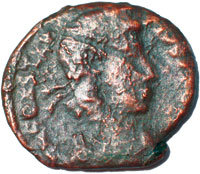The History of Copper
 An early Roman coin made of copper.
An early Roman coin made of copper.Could our civilization thrive, or even survive, without copper and this wondrous metal’s ever-growing number of useful alloys? Put quite simply, no. In the 10 millennia since civilization’s first metal was discovered and put to work on our behalf, it has been celebrated with one use after another.
Early civilizations used copper, and its principal alloys bronze and brass, for any number of important applications, many of which continue today:
- Greek soldiers wore bronze armor — and wielded bronze weapons. Bronze rams on the prows of their fast galleys helped sink the Persian fleet at the climactic battle of Salamis.
- The ahead-of-their-times Egyptians performed complex medical operations with copper-alloy instruments, and copper in various forms was a mainstay in their medicine chests.
- In the ancient world, food was cooked and served in bronze or brass kitchenware. Water was — and still is — stored in copper and brass vessels to prevent growth of pathogens.
- Back then, bronze mirrors allowed potentates and people of high stature to admire themselves, as well as their copper jewelry. All the while, their garments were held together with copperalloy fittings.
- Early local traders — and later, world travelers — depended on coins made of copper or its alloys. Today, nations around the globe still do.
 The development of brass mechanical components made clocks more accurate and durable than previous models that used wooden or iron parts.
The development of brass mechanical components made clocks more accurate and durable than previous models that used wooden or iron parts.The vital importance of copper in our lives is not limited to the far distant past. In the 17th century, brass replaced iron in clock movements. Because brass did not rust, it facilitated the development of increasingly durable and accurate clock construction and shipboard instruments like telescopes, sextants and compasses, making travel over vast oceans — and then long rail lines — safer and more dependable.
Copper contributed to the expansion of the British Empire in the mid-18th century when the Royal Navy discovered that its warships would stay free of worms and barnacles (and sail faster) if the hulls were sheathed in copper.
Still later, the Industrial Age sparked a flood of new copper applications: Fulton’s steamship had copper boilers, as did the first steam-powered locomotives and mining pumps. Early production machinery contained many parts made of copper alloys. Telegraphs, telephones and ocean-spanning communications, all essential to world trade, could only have developed as a result of copper cables. In the same way, the innovation of copper-wound electric motors and generators freed manufacturing from water power and enabled machinery to be located virtually anywhere, and gave rise to automotive mobility that freed mankind to travel whenever and wherever it wished — even to the Moon and beyond.
As all of these examples demonstrate, copper, brass and bronze have played an instrumental role in the growth of civilization and in human history itself — a starring role in which everyone in the metal industry can be proud.
Also in this Issue:
- Four Decades of Innovation: Issues 1 - 25
- Four Decades of Innovation: Issues 26 - 60
- Four Decades of Innovation: Issues 61 - 99
- Copper Shines on Prime Time
- The History of Copper
- The Future of Copper
